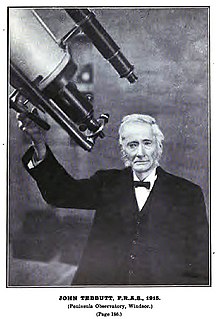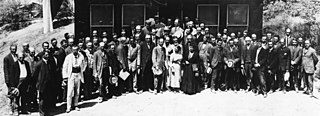
Yerkes Observatory is an astronomical observatory located in Williams Bay, Wisconsin, United States. The observatory was operated by the University of Chicago Department of Astronomy and Astrophysics from its founding in 1897 to 2020. Ownership was transferred to the non-profit Yerkes Future Foundation (YFF) in May 2020, which began restoration and renovation of the historic building and grounds. Re-opening for public tours and programming began May 27, 2022.

John Tebbutt was an Australian astronomer, famous for discovering the "Great Comet of 1861".
The British Astronomical Association (BAA) was formed in 1890 as a national body to support the UK's amateur astronomers.

Perkins Observatory is an astronomical observatory in Delaware, Ohio. It is owned and operated by Ohio Wesleyan University.

The Kodaikanal Solar Observatory is a solar observatory owned and operated by the Indian Institute of Astrophysics. It is on the southern tip of the Palani Hills 4 kilometres (2.5 mi) from Kodaikanal town.
Leuschner Observatory, originally called the Students' Observatory, is an observatory jointly operated by the University of California, Berkeley and San Francisco State University. The observatory was built in 1886 on the Berkeley campus. For many years, it was directed by Armin Otto Leuschner, for whom the observatory was renamed in 1951. In 1965, it was relocated to its present home in Lafayette, California, approximately 10 miles (16 km) east of the Berkeley campus. In 2012, the physics and astronomy department of San Francisco State University became a partner.
The Amateur Astronomers Association of Pittsburgh (AAAP) is an Astronomical Organization founded on June 9, 1929, by Chester B. Roe and Leo J. Scanlon. Since then, it has grown to over 500 members and operates two observatories in the Pittsburgh region: the Nicholas E. Wagman Observatory and the Mingo Creek Park Observatory. The club also sponsors many star parties that are open to members of the public throughout the year.

Green Point Observatory is a private observatory in Oyster Bay, Sydney, Australia, and is the home of the Sutherland Astronomical Society. It is located at the corner of Green Point and Caravan Head Roads. It consists of a dome, library, 41 centimetres (16 in) Newtonian telescope, a meeting hall seating 100 people, and a roll-off roof observatory with a 35 centimetres (14 in) Schmidt Cassegrain Telescope. The observatory is used by members of the society for observing stars and eclipses, research, astro imaging as well as hosting public education courses and monthly open nights.
The Royal Astronomical Society of Canada (RASC) is a national, non-profit, charitable organization devoted to the advancement of astronomy and related sciences. At present, there are 28 local branches of the Society, called Centres, in towns and cities across the country from St. John's, Newfoundland, to Victoria, British Columbia, and as far north as Whitehorse, Yukon. There are about 5100 members from coast to coast to coast, and internationally. The membership is composed primarily of amateur astronomers and also includes numerous professional astronomers and astronomy educators. The RASC is the Canadian equivalent of the British Astronomical Association.

Fuertes Observatory is an astronomical observatory located on the North Campus of Cornell University in Ithaca, New York. The observatory was designed by L.P. Burnham, Cornell Professor of Architecture and completed in fall of 1917. It was originally used by the Civil Engineering Department as an instructional field office for navigation and surveying. Today, the observatory is primarily used for public outreach, welcoming over two thousand visitors per year with open houses on clear Friday nights.
Mansfield and Sutton Astronomical Society (MSAS) is an amateur astronomical society in the East Midlands of England. It was formed in 1969. It is based at Sherwood Observatory, a 61 cm mirror telescope which it owns and operates. The observatory lies 4 km south west of the centre of Mansfield on one of the highest points in the county of Nottinghamshire.
The Dunedin Astronomical Society Incorporated (DAS) is an amateur astronomical group operating from the Beverly-Begg Observatory Dunedin, New Zealand. It is affiliated with the Royal Astronomical Society of New Zealand and with the Otago Institute.

Sutherland Astronomical Society Incorporated (SASI) is an amateur astronomical society based in the Sutherland Shire, in the southern suburbs of Sydney, Australia. It operates the Green Point Observatory, it is one of the two founding organizations of the National Australian Convention of Amateur Astronomers, and its members have discovered two comets and two novae.

Powell Observatory is an astronomical observatory located near Louisburg in Miami County, Kansas. It features several large telescopes and is available for public viewing, for private use of Astronomical Society of Kansas City members, and for ongoing research projects.
The Astronomical Society of India (ASI) is an Indian society of professional astronomers and other professionals from related disciplines. It was founded in 1972, with Vainu Bappu being the founder President of the Society, and as of 2010 has a membership of approximately 1000. Its registered office is at the Astronomy Department, Osmania University, Hyderabad, India. Its primary objective is the promotion of Astronomy and related branches of science. It organises meetings, supports and tries to popularise Astronomy and related subjects and publishes the Bulletin of the Astronomical Society of India.

Thomas Thorp (1850–1914) was an English manufacturer of scientific instruments credited with inventing the first practical coin-in-the-slot gas meter, with innovations in the field of photography, including that involving colour, and for producing an early example of what has since been developed into the modern spectrohelioscope. He began his working life as an apprentice to a firm of architects and ended it as a Fellow of the Royal Astronomical Society, having had a keen interest in astronomy since childhood.

The Astronomical Society of Glasgow (ASG) was founded in 1954 in Glasgow, Scotland, by amateur astronomers and is dedicated to promoting an interest in Astronomy.

Aloysius Laurence Cortie was an English Jesuit astronomer. He served as director of the Stonyhurst College Observatory and contributed to the study of the Sun, including through observing solar eclipses.

The Hampstead Scientific Society (HSS) in north London was founded in July 1899 as the Hampstead Astronomical and General Scientific Society by P.E. Vizard. It aims to be inclusive, promoting and nurturing an interest in all branches of science, while catering for wide levels of knowledge, from layman to expert alike. The society maintains specialist astronomy and meteorology sections and runs a programme of lectures on various scientific topics in the Hampstead area of North West London.

The Astronomical Society of Edinburgh (ASE) is an association of amateur astronomers and other individuals interested in astronomy, which is based in Edinburgh, Scotland. The objectives are to encourage astronomical study and observation and to increase popular interest in astronomy.













